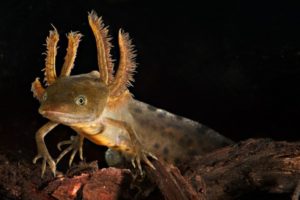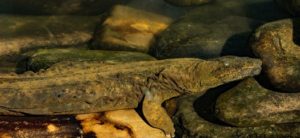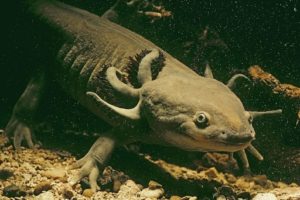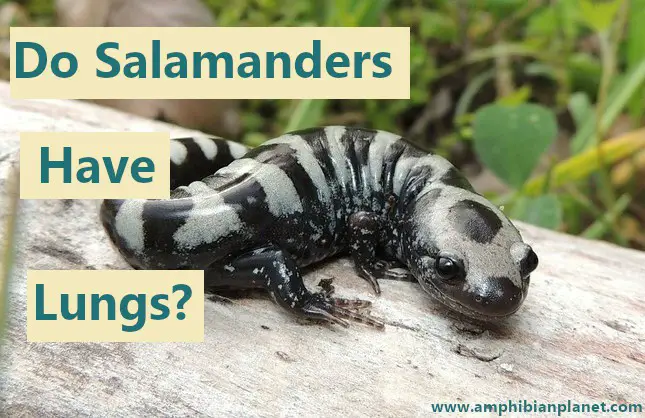If you ever look at a salamander, you will notice it looks so much different from other animals. But have you ever wondered what it has on the inside? Do salamanders have lungs as most other animals do?
There are over 600 salamander species, that are all somewhat different from each other. Some salamanders such as the spotted and tiger salamander have lungs as adults. Others, such as red and dusky salamander do not have lungs and breathe entirely through their skin.
Many aquatic salamanders have both gills and lungs, but some only have lungs. However, despite having lungs, gillless aquatic salamanders mostly breathe through their skin.
List of Salamanders That Do, or Do Not Have Lungs
Below is a chart that shows salamanders that have lungs, those that don’t, and those that have both gills and lungs.
Salamanders with lungs/ Lunged salamanders |
Lungless Salamanders |
Salamanders with both gills & lungs |
| Tiger Salamander | Red Salamander | Axolotl |
| Yellow-Spotted salamander | Mud Salamander | Mudpuppy |
| Blue-spotted Salamander | Four-toed Salamander | Greater Siren |
| Marbled Salamander | Red-backed Salamander | Lesser Siren |
| Fire Salamander | Dunn’s Salamander | Anderson’s Salamander |
| Jefferson Salamander | Larch Mountain Salamander | |
| Small-mouthed Salamander | Del Norte Salamander | |
| Yellow-peppered Salamander | Siskiyou Mountains Salamander | |
| Ringed Salamander | Ensatina Salamander | |
| Blunt-headed Salamander | Clouded Salamander | |
| Streamside Salamander | Klamath black Salamander | |
| Flatwoods Salamanders | Slender Salamanders | |
| Delicate-skinned Salamander | Slimy/Woodland Salamanders | |
| Northwestern Salamander | Spring Salamander | |
| Silvery Salamander | Brook Salamander | |
| Long-toed Salamander | Two-lined Salamander | |
| Chinese & Japanese Giant Salamander | Green Salamander | |
| Hellbender | Red Hills Salamander | |
| Red-spotted newt | Cave salamander | |
| Fire belly newt | Dusky Salamanders |
Keep in mind this table does not list all the salamanders in the world. Remember, there are over 600 salamander species, so these are only a few of them.
Also, many salamander species haven’t been extensively studied by scientists, so there is very little scientific information about them. The little information out there is largely unverifiable.
Most Salamanders Start Their Lives With Gills
The majority of salamanders start their lives as tiny aquatic larvae, that look somewhat similar to frog tadpoles. These larvae have external feathery gills and live entirely in the water.
At this stage, salamanders use their gills to breathe in the water, just like fish. Dissolved oxygen in the water that comes in contact with their gills is absorbed into the bloodstream. At the same time, carbon dioxide from the bloodstream passes through the gills and is diffused into the water.

After a few weeks, the larvae will go through a process known as metamorphosis, to transform into the adult salamanders you are more familiar with.
During this process, terrestrial salamanders will lose their gills and develop strong legs for walking on land. Some aquatic salamanders also lose their gills and develop lungs, but others develop lungs while also keeping their gills.
Some Salamanders Develop Lungs as They Transform Into Adults
After fully going through metamorphosis, salamanders such as the spotted, and tiger salamander will lose their gills and develop lungs for breathing air. That said, amphibian lungs do not work like our own.
Salamanders (like all amphibians), do not have a rib cage or diaphragm to move air in and out of their lungs. Instead, they use something called “gular pumping” to push air in and out of their lungs.
To breathe in, the salamander expands its throat by lowering the floor of the mouth. Air then rushes into the throat cavity through the mouth and nostrils. To push the air into its lungs, the salamander will contract the floor of its mouth. When breathing out, this process is simply reversed.
However, this process isn’t very efficient, so lunged salamanders can also breathe through their skin to make up for it. This is known as cutaneous respiration. More information on that is below.
Other Salamanders Develop to Breathe Entirely Through Their Skin
While some salamanders develop lungs after transforming into adults, others, known as “lungless salamanders,” do not. Instead, these salamanders develop to breathe entirely through their skin, and thin membranes in their mouth and throat.

Lungless salamanders (like all salamanders) have moist permeable skin with thousands of capillaries and other blood vessels very close to the skin surface. Oxygen that comes in contact with this skin is absorbed into the bloodstream via diffusion.
At the same time, carbon dioxide from the bloodstream passes through the skin and is diffused into the atmosphere.
This process of “skin breathing” (cutaneous respiration) is very efficient in lungless salamanders, so it gives them all the oxygen they need. However, it is not as efficient in lunged salamanders, so they also need to use their lungs to get extra oxygen.
Many Aquatic Salamanders Have Both Lungs & Gills
Unlike terrestrial salamanders (salamanders that live on land), aquatic salamanders live their entire lives in the water even after transforming into adults. These salamanders develop lungs as they grow from larvae into adults, but some species also keep their gills.
Aquatic salamanders such as the hellbender lose their gills and develop lungs as they mature into adults. However, their lungs are largely non-functional and used for buoyancy rather than breathing.
These lungs inflate and deflate like a fish’s swim bladder, enabling to salamander to float or sink into the water.

On the other hand, aquatic salamanders such as sirens and Axolotls keep their gills but also have fully functional lungs which they occasionally use to breathe air from the water’s surface. Sirens are even known to periodically venture out of the water and walk on land.
In short, the most important points to grasp from this section are:
- Axolotls and sirens have gills, but also have fully functional lungs which they can use to breathe air
- Mudpuppies have both gills and lungs, but their lungs are mostly used for buoyancy rather than breathing
- Hellbenders do not have gills as adults and breathe entirely their skin. They also have lungs, but they are mostly used for buoyancy like those of the mudpuppy.
Some Normally Terrestrial Salamanders Keep Their Gills as Adults
Most terrestrial salamanders lose their gills as they grow into adults. However, this development occasionally takes an odd turn and the larvae mature into adults without first going through the normal process of metamorphosis.
This is known as “neoteny” and is most common with tiger salamanders. It is essentially the failure to grow up.
Neotenic salamanders never develop lungs and keep their gills and other larval features as they mature into adults. They also continue to live in the water just like the larvae.

Neoteny usually happens when the salamander larvae are in a pond with lots of food, and a lack of predators making it unnecessary for them to transform into land-dwelling adults.
It can also happen when the larvae are in closed-off bodies of water such as a reservoir. The larvae that transform into land-dwelling adults won’t be able to get out of the water and will die. To avoid this, some of the larvae will simply become neotenic and live fully aquatic lives into adulthood.
Frequently Asked Questions
Question: Do Salamanders Have Scales?
Answer: Salamanders are amphibians, just like frogs and toads. They do not have scales like lizards, rather they have smooth moist skin.
They use this skin to breathe and absorb water into their bodies. To prevent their skin from drying out, most salamanders live in moist habitats close to streams or ponds
Question: Are Salamanders Poisonous?
Answer: Like most amphibians, most salamanders (not all) produce toxic milky secretions on their skin to defend against predators.
The toxins produced by the majority of salamanders are mild, only having the effect of making the salamander taste bad to any animals that try to eat it. But, some salamanders such as the fire salamander produce extremely potent toxins.
Check this post about the toxicity of salamanders for more thorough information on the topic.
Question: Are Salamanders and Newts the Same Thing?
Answer: Newts are a type of salamander and in the salamander family. Most scientists do not make a scientific distinction between newts and “true salamanders.” The distinction is usually only made in informal circles.
Final Thoughts
Salamanders are intriguing creatures that tend to capture the curiosity of many people. Now you know that some salamanders have lungs while others only breathe through their skin (cutaneous respiration).
However, even salamanders that breathe air with their lungs can breathe through their skin (though not as good as lungless salamanders).
If you want to know whether or not a particular type of salamander has lungs, just look up if it is classed under “lunged” or “lungless” salamanders. Have fun!


